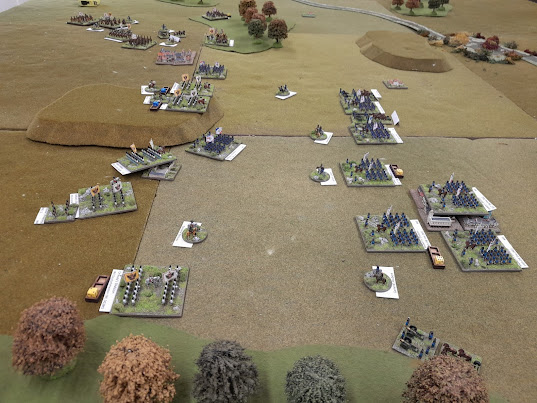Last weekend a diminished complement of Rejects assembled for a fictional French Revolutionary Wars scenario. We used Volley and Bayonet rules and deployed Commission Figurines 6mm MDF miniatures.
This was the first time we had played these rules face to face, and on a large table. Up to now on a 6x4 table, but on this occasion on a 8x6 battlefield. So, we were all looking forward to seeing how things played out on this larger arena. Plus, Surjit and Steve were keen to understand the rules better in anticipation of campaign battles. More on this in a future post.
The Context
Put simply, it was a encounter between two roughly equal sides.
Victory would come from taking and holding the opponent's line of communication or having less divisions exhausted.
The Sides
Apologies for the poor quality reproductions of the orders of battle.
The Austrians - Stuart and Surjit.
The French - Steve.
The Battle
With the French on the right, they advanced all along the line. With all their cavalry placed on their right flank, Massena and Bonaparte push across the stream. The Austrians (on the left), having divided their cavalry on both flanks decided that they needed to react to this and rapidly sought to redeploy their horse to cover the far flank.
 |
| Stuart and Surjit react to Steve's advance. |
The Austrians manage to race their dragoons to the far flank just before the French cavalry emerged from the orchards. Along the rest of their line imperial forces adopted a defensive posture in the hope that the French would break against them.
 |
| The Austrians use the large, dense woods to anchor their centre, and trust to their cavalry to protect the more open far flank. |
Hoping to smash the near flank, the French commander threw Vial's division at the Austrians on the hill. Whilst maximising their position and stationary posture, Sebottendorf's division repulsed the assault.
And attempted to seize the opportunity to open up the French flank. At this point the French commander was showing signs of a collapse of morale, and as he munched on his lunch he predicted that not half an hour would pass before the battle was concluded.
However, fortune is not a faithful mistress and quickly turned away from the Austrians as French columns assaulted the centre, driving back or routing four imperial regiments.
Even the far flank was looking brittle.
From near morale collapse to feelings of invincibility, the French commander was now taking the fight to the slightly stunned Austrians.
 |
| Steve and his renewed luck... he needed sixes! |
On the far flank, all the cavalry engaged with the French maximising their horse artillery advantage.
With honours edging towards the French, it nonetheless looked likely that all mounted divisions would exhaust themselves.
The Austrian position all along the line was being tested by the newly invigorated and confident French.
However, the Austrians were inducing some nervous tension on the French right (near) flank. With Sebottendorf's division throwing themselves at the well placed guns and a recovering demi-brigade, Austrian expectations hoped for a breakthrough.
Alas, sterling gallic defence and a reasonable amount of good fortune repelled the attack. However, both divisions had exhausted themselves in their mutual efforts. The brave men of Vial's division nonetheless held their morale, whilst Sebottendorf's collapsed. Two regiments scattered and a third would rout. The battle for this flank was over.
Meanwhile, the Austrian command was working hard to recover the centre. Especially now that the hill seemed about to be flanked.
The French, though bloodied, could scent victory and with undamaged reserves ready to throw forward with artillery support the battle seemed now to have swung in their favour.
With a central division approaching exhaustion, the Austrians made the decision that this would be an opportune moment to retire in good order. Well timed as the God of War (me) was about to call the battle to a conclusion.
 |
| The rather more confused situation at the end of the game. Both flanks were exhausted and the Austrian centre was giving ground. |
Conclusion
A French victory in what was a close match.
The players enjoyed the battle more from the point of view of learning more about the nuances of the rules and how to handle the units than from any desire to desperately win. Their stream of questions was constant. They seemed to gain a greater understanding of the advantages and disadvantages of batteries versus detached guns.
From my perspective it was really interesting to see how the players made use of the bigger table. I'm not sure it actually made a lot of difference in this game. Primarily because the two armies were too evenly balanced, which made for bold advances followed by calculated caution in the knowledge that the balance might be broken against them. Plus, it made us all think about the wisdom of only seeking battle with distinct numeric or qualitative advantages. This game was too balanced, and so could easily swing on small events or lucky dice rolls.
Nonetheless, a excellent and enjoyable day full of banter, laughter and great conversation.































































